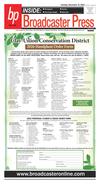10
10 Broadcaster Press
March 17, 2015 www.broadcasteronline.com
March
15 - 21, 2015
Drainage Calculators Now Available
Growing Vines In The
Upper Midwest
ROSHOLT (AP) — A winery
in Rosholt doubles as a family
home for a couple who recently
moved back to South Dakota to
start their grape-growing and
winemaking business.
According to the Watertown
Public Opinion, Jeremiah and Lisa
Klein were inspired by a news
article about growing grapevines
in the Upper Midwest to bring
With the Wind Vineyard & Winery
to fruition in the far northeast
corner of South Dakota.
“We had been looking at an
abandoned farm property just
to live on, and my husband
wondered if the soil there
would be the right type to grow
grapevines, which we thought
would be a fun hobby,” Lisa Klein
said.
Tests of the soil done by
Jeremiah Klein, who worked in
the agriculture industry, found it
was good for grapes.
The couple purchased the
property about three years ago
and built a winery in the same
building where they live. The
wine-making facility and tasting
room are on the first floor, while
the Kleins, including their three
children, live on the second floor.
They grow four varieties
of grapes: Brianna, Frontenac,
Frontenac Gris and King of the
North. Their stainless steel
fermentation tanks come from
Italy.
Jeremiah Klein learned
how to produce wine by taking
science courses through South
Dakota State University and
completing an online winemaking
program through the University
of California, Davis. Lisa Klein
said she helps with tasting and
business decisions.
So far, the couple has 900
vines on 1.5 acres just south of
Rosholt, about seven miles east of
Interstate 29. “We have 10 acres
available for growing grapes,”
Lisa Klein told the Capital Journal.
Their entire farm is 20 acres.
Last June, the first
“commercial batch” of their
wine was available, 2013 vintage,
she said. “The 2014 vintage will
come later this spring into early
summer.”
The winery opened to the
public in June. Besides raising
grapes and making wine, the
family holds regular tastings
and sells the wine in nearby
stores. “They served our wine
at the inaugural ball in Pierre in
January,” Lisa Klein said.
? Smile.
BROOKINGS - SDSU Extension recently released
web-based drainage calculators for tile drainage and
subirrigation design. Contractors and farmers can
access these calculators at www.iGrowDrainage.
org. The calculators are compatible with a variety
of devices allowing for in-field use.
“For years farmers and contractors have asked
our team to develop calculators they could use in
the field because several calculations are needed
when designing drainage systems on agricultural
land,” explained Chris Hay, SDSU Extension Water
Management Engineer.
To meet this demand, Hay and his team took
research-based calculations and designed several
easy-to-use calculators which address common
drainage design calculations to provide farmers and
contractors with in-field data they need.
“These are equations that we as engineers like
to play around with but aren’t always the easiest
to use. The calculators are designed to make it
easy to get quick answers so they can get the job
done right,” Hay said. The calculations Hay references
provide research-based guidance to boost productivity
and minimize downstream impacts on everything from
drain spacing and pipe sizing, to subirrigation and lift
station design.
“When tiling, the calculations need to be correct
in order for the drainage system to meet the farmer’s
goals and function properly. Once you put the pipe in
the ground, the goal is that it will last 50 to 100 years or
more without issues,” Hay said.
Tiling is designed to drain excess moisture off fields
that have reached their holding capacity. “Many soils in
the Upper Midwest do not drain well because of glacial
influence,” Hay explained. “Many fields sit on top of
layers of glacial till or other restrictive layers that can
limit natural drainage.”
Demand for tile drainage is up in portions of South
Dakota where excess field moisture can delay or
PHOTOS COURTESY OF IGROW.ORG
prevent planting, explained Nathan Utt, Agricultural
Engineer with Ecosystem Services Exchange. “There
is an increase in drainage installation and a growing
number of people who are doing the installation. Not
only contractors, but farmers and other landowners
who are installing their own drain tile,” said Utt who
has been working with agricultural drainage since
2007 and as an engineering consultant in the field for
three years. “These calculators are helpful because
they provide accurate numbers for factors like
optimum drainage spacing, which is critical to system
performance as well as minimizing system cost,” Utt
said.
The calculators were developed in cooperation with
University of Minnesota Extension. To learn more and
access the calculators, visit www.iGrowdrainage.org.
n SDSU iGROW
Cover Crop Cost$? There’s An App For That!
Planting cover crops is a hot
trend but farmers who haven’t tried
it yet have one question: “What’s it
going to cost me?” USDA’s Natural
Resources Conservation Service
(NRCS) developed a simple digital
tool to answer that question. It’s
called the Cover Crop Economic
Decision Support Tool. It helps
farmers, landowners and others make
informed decisions when considering
adding cover crops to their
production system. And it’s free.
“The tool offers a partial budget
analysis,” explains Ivan Dozier, Illinois
NRCS State Conservationist. “It
focuses only on operational changes
farmers make—actual costs and
benefits farmers see when they add
in cover crops. We focus on benefits
and costs we can easily express in
dollars,” Dozier adds.
Benefits & Costs To Measure
Direct nutrient credits
Input reductions
Yield increases & decreases
Seed & establishment costs
Erosion reductions
Grazing opportunities
Overall soil fertility levels
Water storage & infiltration
improvements
The tool’s analysis depends on
data users enter. Users can run “what
if” scenarios if they want to evaluate a
range of values. The tool offers results
in both dollars and graphs, showing
short- and long-term benefits.
“Our hope is that answers to
some of the big economic questions
will help more Illinois farmers give
this conservation option a try,” says
Dozier. According to NRCS and other
research, long-term results in renewed
soil health offer huge returns in crop
yields, water quality and infiltration
improvements, weed and pest control
and more. “Cover crops are a good
trend and one that can actually pay
off,” Dozier adds.
This NRCS tool, which is being
used nationwide, was
developed by Agricultural
Economists in Missouri and
Illinois. Farmers can download
the spreadsheet and run it at
Specializing in
Irrigation
Well Service
http://www.nrcs.usda.gov/wps/
portal/nrcs/detailfull/il/soils/
health/?cid=stelprdb1269028 or
visit the Illinois website and
find a factsheet about the tool
and download the tool there.
n Natural Resources
Conservation Service
Jeremy Promes - Owner
Licensed & Certified in SD & NE
Quality Well
Service LLC
Call for all your Well Service needs
402-841-0535
FOR ALL YOUR
Fertilizer • Crop Protection
and Custom Application needs
Stop in today and visit with your local rep!
New Homes
Office: 605-761-1001 • 47261 SD Hwy 48
Elk Point, SD 57025 • valleyagsupply.com
Chad Van Laecken
605.310.1080
Remodeling
Brian Gaulke
605.660.4735
900 W. Spruce St., Mitchell, SD 57301
605.990.2710 • c.e@mit-tel.net
Need a better
way to get
around?
Check out our
Automotive
Classifieds for a
reliable ride!
Broadcaster
201 W. Cherry St.
624-4429
Classifie
get the
job
done!
Broadcas
201 W. Cherry
624-4429



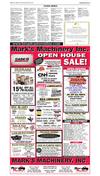


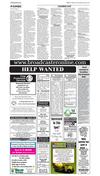
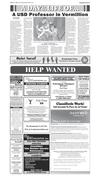




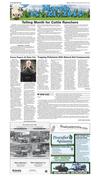
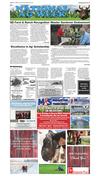

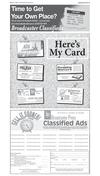
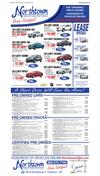
 Previous Page
Previous Page



